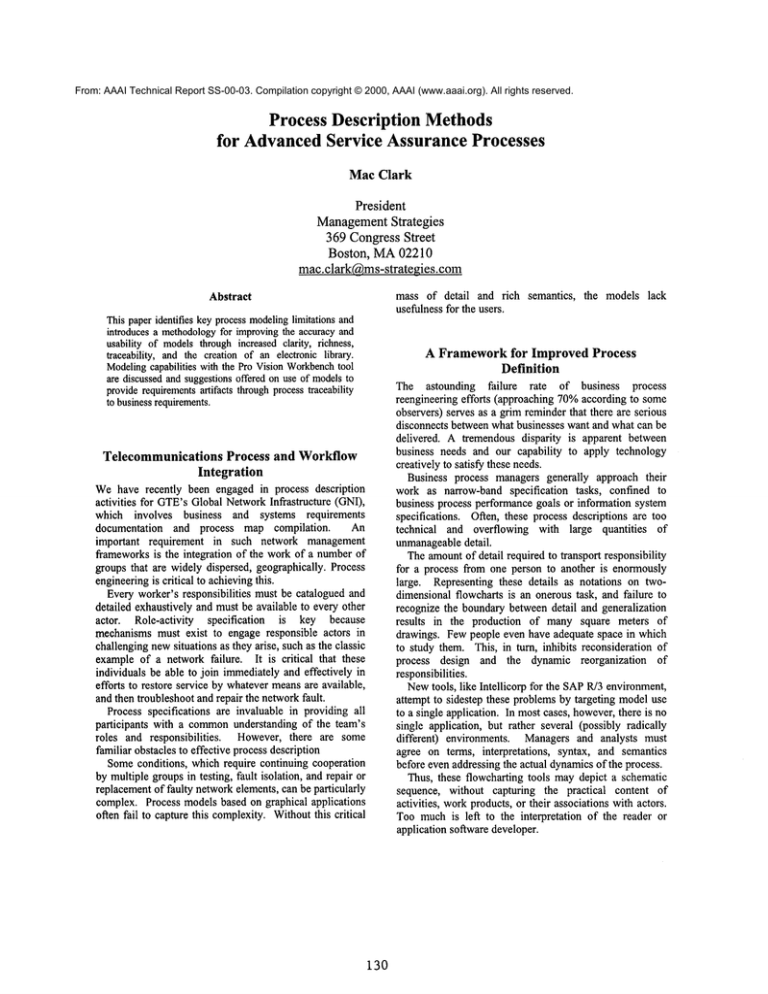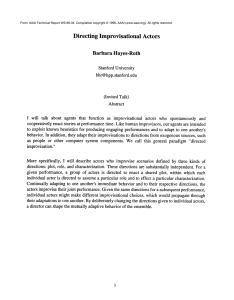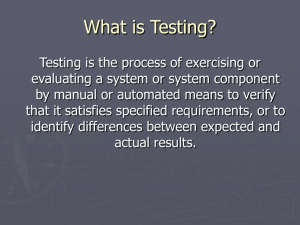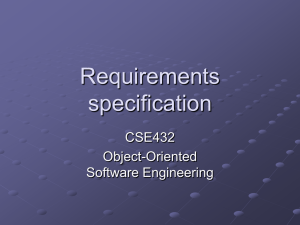
From: AAAI Technical Report SS-00-03. Compilation copyright © 2000, AAAI (www.aaai.org). All rights reserved.
Process Description Methods
for AdvancedService Assurance Processes
Mac Clark
President
Management
Strategies
369 CongressStreet
Boston, MA02210
mac.clark@ms-strategies.corn
mass of detail and rich semantics,
usefulness for the users.
Abstract
This paperidentifies keyprocess modelinglimitations and
introduces a methodology
for improvingthe accuracy and
usability of modelsthrough increased clarity, richness,
traceability, and the creation of an electronic library.
Modelingcapabilities with the Pro Vision Workbench
tool
are discussedand suggestionsoffered on use of modelsto
providerequirementsartifacts throughprocesstraceability
to businessrequirements.
the models lack
A Frameworkfor Improved Process
Definition
The astounding failure
rate of business process
reengineering efforts (approaching 70%according to some
observers) serves as a grim reminder that there are serious
disconnects between what businesses want and what can be
delivered. A tremendous disparity is apparent between
business needs and our capability to apply technology
creatively to satisfy these needs.
Business process managers generally approach their
work as narrow-band specification tasks, confined to
business process performance goals or information system
specifications. Often, these process descriptions are too
technical and overflowing with large quantities of
unmanageabledetail.
Theamountof detail required to transport responsibility
for a process from one person to another is enormously
large. Representing these details as notations on twodimensional flowcharts is an onerous task, and failure to
recognize the boundary between detail and generalization
results in the production of many square meters of
drawings. Few people even have adequate space in which
to study them. This, in turn, inhibits reconsideration of
process design and the dynamic reorganization
of
responsibilities.
Newtools, like Intellicorp for the SAPR/3 environment,
attempt to sidestep these problems by targeting modeluse
to a single application. In most cases, however,there is no
single application, but rather several (possibly radically
different) environments. Managers and analysts must
agree on terms, interpretations,
syntax, and semantics
before even addressing the actual dynamicsof the process.
Thus, these flowcharting tools may depict a schematic
sequence, without capturing the practical content of
activities, workproducts, or their associations with actors.
Too muchis left to the interpretation of the reader or
application software developer.
Telecommunications Process and Workflow
Integration
Wehave recently been engaged in process description
activities for GTE’sGlobal NetworkInfrastructure (GNI),
which involves business and systems requirements
documentation
and process map compilation.
An
important requirement in such network management
frameworksis the integration of the work of a numberof
groups that are widely dispersed, geographically. Process
engineeringis critical to achievingthis.
Every worker’s responsibilities must be catalogued and
detailed exhaustively and must be available to every other
actor. Role-activity
specification
is key because
mechanisms must exist to engage responsible actors in
challengingnewsituations as they arise, such as the classic
example of a network failure. It is critical that these
individuals be able to join immediatelyand effectively in
efforts to restore service by whatevermeansare available,
and then troubleshoot and repair the networkfault.
Process specifications are invaluable in providing all
participants with a commonunderstanding of the team’s
roles and responsibilities.
However, there are some
familiar obstacles to effective process description
Someconditions, which require continuing cooperation
by multiple groups in testing, fault isolation, and repair or
replacementof faulty networkelements, can be particularly
complex. Process models based on graphical applications
often fail to capture this complexity.Withoutthis critical
130
process modelsreadily, but then fail to apply themin real
life.
Consequently, a disparity quickly develops betweenthe
recorded baseline and the actual work carried out in the
Network Operations Center. The AVPin charge of
Operations for GTE’s GNI attacked this problem by
commissioning the development of an Electronic Library
(Figure 1).
Breaking the Chains of "Old" Process Thinking
This paper introduces a methodology for significantly
improving the accuracy and usability of process models.
We see three outstanding objectives: (1) Clarity and
Richness: Clarity of process must combinewith richness of
detail. (2) RequirementsTraceability: process detail must
mapexplicitly to requirements. (3) Electronic Library:
information for users must be made available in a welldesigned and well-maintained knowledgebase.
1. Clarity and Richness
The richest possible concentration of information about
workis the minimalstarting point for a successful process
description. Only the fullest possible collection of basic
information can yield useful results. The alternative is
misunderstanding, oversimplification, and ruinous rework.
A business process specification must deliver a concrete,
practical and graphical description of howactual actors
perform actual work. The process description will portray
the highest levels of relevant business requirements and
descend in orderly stages to the most detailed diagrams of
daily work. The higher levels of process description
convey a general overview to business owners and users;
and are required in order to demonstrate the dependenceof
moredetailed processes on broader structures and policies.
Figure1
There are three core activities within the Monitoring
process: (1) Registering Alarms: network management
systems deliver alarms and performance data, eliminate
duplicates and associate alarms from different protocol
layers. (2) Correlating: personnel must perform special
correlation procedures in order to identify customersbeing
affected by faults, or confirm and identify, amongknown
or unknownnetwork events, trouble situations reported by
customers. (3) Testing: of network elements to identify the
root causeof trouble.
Now, when a network error occurs, the monitoring
workstation automatically links to a WindowsNT Web
server that provides access to the Electronic Library - an
alarm knowledge base. This web-based resource provides
a wealth of structured details including troubleshooting and
repair information. Eventually, the Library will contain
detailed specifics for all aspects of the Service Assurance
process.
A knowledge base such as this is a powerful mechanism
for injecting key details about specific network elements
and events, when and where the monitoring engineer
requires them.
2. RequirementsTraceability
Generally, even after a completed model exists,
requirements must be generated in written form. After all,
vendors or development organizations have to bid on the
job and process and object modelsare seldomsufficient for
contractually binding negotiations and specifications.
Correlating business requirements with their functional
expressions, and clearly documenting these links are
complexand tedious tasks at best.
These tasks may be made easier by using detailed
models as a source from which to generate requirements
information. Each business requirement maybe linked to a
componentof the process model, just as each part of the
process cross-references to a business requirement.
Requirements management soft-ware may be used in
conjunction with an interface to establish direct linkages
between requirements and process models.
3. The Electronic Library - A Process Knowledge
Repository
As we mentioned earlier, full specification of a process
requires an enormousamountof detail, moredetail, in fact,
than one can easily express in a standard model.
For this reason, manymodelsdo not offer the detailed
and explicit decision trees which operating personnel need
in order to carry out triage of a collection of network
problems or conduct complex troubleshooting procedures.
Network operations personnel may initially accept the
Other Derivations
Other similar features can also assist business managers
and operations personnel in making the most of process
models. As the diagram(Figure 2) shows, it is possible
derive several useful process-engineeringartifacts directly
from the modelsand their annotations.
131
Derivations
From the Process Models
Access Table
Prov don WoTkb.neh
I
Requirements
~Wor[
.....
ow
~~11~
Model Interpretations
~
Figure 2
Information about actors and work is gathered from
interviewing people and researching business documents.
Snapshots of characteristic work scenarios are assembled,
diagrammed,checked and refined, to project a catalog of
roles and responsibilities,
actors and tasks and of
relationships with other actors and tasks. As we catalog
these elements in finer detail, we gradually arrive at a
reliable picture of what is currently being done, what needs
to be done, and what is doable.
Suchderivations include those listed in the table below
(Figure 3). Fully implementedinstances of each of these
were developed to support GNI Service Assurance
processes. Small examples can be found at the URL
http:\\processexamples.paper.jsac.gte.com
ModelInterpretations
Workflow
Rules
Rules
Organized, highly
structured tabulations of
details about the models
It is possible to generate
workflowdefinitions
automatically, and inject
these into a commercial,
off-the-shelf workflow
engine like Flowmark(this
is the subject of a separate
paper).
Process models can be
annotated with specific
business rules that can then
feed software
development, manual
procedures, or the
Electronic Library.
Types of Diagrams
Tactical process description employs graphic modeling
tools to catalog business objects and relationships. From
this, a detailed Object Model may be elaborated, and a
system workflow specified.
Organizations, roles,
processes and activities can be modeled in hierarchies,
showing the dependence of detailed entities on general
ones. Pro Vision Workbenchoffers modelingtools for this
logical phase of process description as well, in a range of
modeling systems, including UML.
Organizational Interaction Modelsdisplay the broad
relations amongorganizations and roles.
WorkflowModels display the sequence of steps in
work, mapactivities to actors, indicate systems and tools,
identify outputs, diagram vectors of the process, and
documentrules governing the execution of steps.
Figure3
Process Description in Practice
Process description begins with identification of actors and
their spheres of work. Actors are groups and individuals
who perform work in organizations and roles, often in
contact with external actors, e.g., customers and vendors.
Work,in turn, is moreor less specific activity, rising to
process.
Use Case Modelsdepict detailed inputs and outputs to
and from activities. They serve as excellent sketches or
diagrammatic notes for detailed workflowmodels.
132





